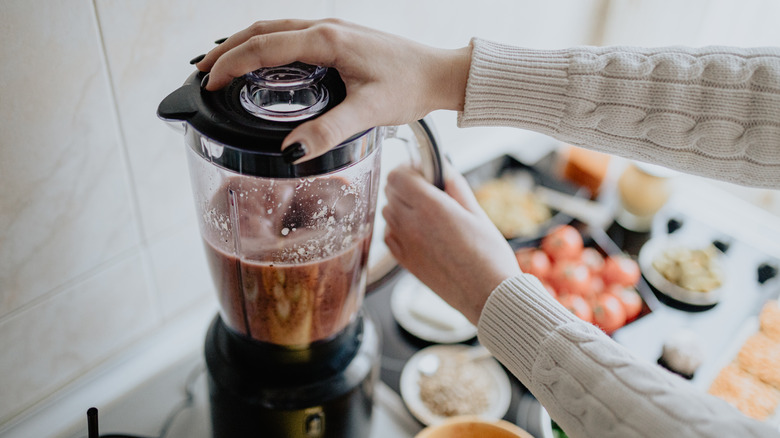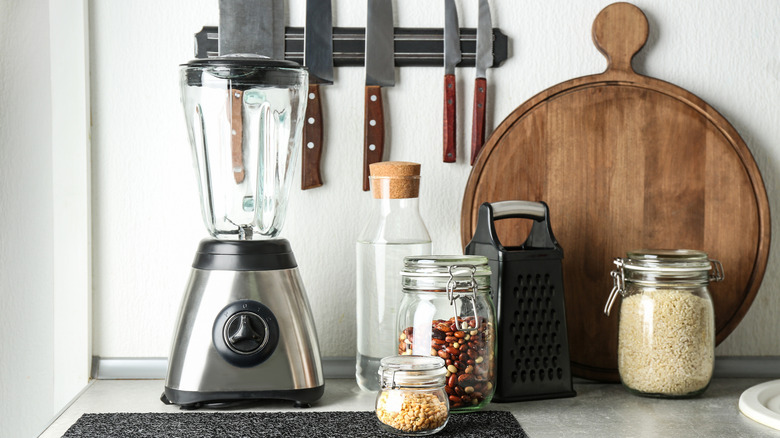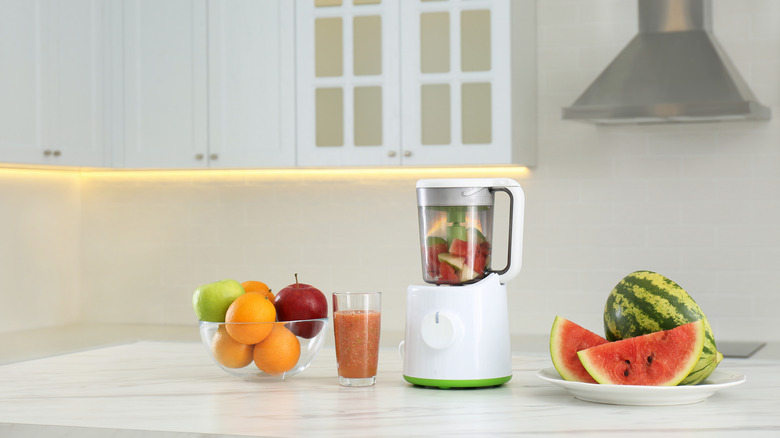The Easy Towel Trick For Muffling The Sound Of Your Blender
The blender may be an incredibly useful kitchen appliance, but it definitely isn't a quiet one. Smoothies make for a healthy and filling breakfast, not to mention an easy one, but you can't make one without waking up everyone else in the house (and rudely, at that). You'd think by this point in history, we'd have a way to make homemade pesto without scaring our pets or rousing our roommates. And yet, even the best blenders are pretty disruptive — the more powerful the motor, the louder it tends to be.
Unless you feel like shelling out a couple hundred dollars for a special box to muffle the sound of your blender (yes, they're a thing), there are some simple steps you can take with stuff you already have at home — like, for instance, a tea towel.
When you hit that "blend" button, the sound of the motor is amplified by the powerful, noisy vibration against your countertop. Absorbing some of that vibration will help soften the sound, and one simple and reliable way to do that is by simply placing the blender on top of a folded tea towel or silicone mat. It may not make your food prep process totally silent, but your neighbors will likely appreciate the reduction in volume.
Out of the echo chamber
If you've ever noticed how much more loudly your phone vibrates when on your nightstand than, say, on your bed, you know that hard, hollow surfaces are prone to causing echoes. It just so happens that kitchen counters and islands are essentially big empty boxes, which can really amplify the sound of a noisy blender. If you keep your blender on a free-standing kitchen cart, it's probably even worse.
But a simple dish towel or tea towel can provide some insulation and thus muffle the sound. A thicker towel will absorb the sound more effectively, just be sure it doesn't obscure the vents so that the blender doesn't risk overheating.
Other soft materials can achieve a similar effect. If you have any flexible silicone baking sheets, like the kind often used to make cookies (though you maybe shouldn't), that's a great option, too — in the case of splatters, you can just wipe it down in seconds. Whatever you use, just be sure that the blender is still sturdily positioned, and again, that the vents aren't blocked.
Acoustic (kitchen) set
You may be able to make some blender-quieting adjustments to your kitchen layout, depending on where things are. If you keep your blender in a fairly tight space, like on the kitchen counter up against the wall beneath the cabinets, these surfaces can create echoes that make the blender seem even louder. If possible, plug it in somewhere the machine has some space around it, like in the center of the countertop, pulled away from the wall, or better yet, all alone on a kitchen island.
But apart from insulating your blender with absorbent surfaces and keeping it away from rattling furniture, there's really not much else you can do. Covering the whole machine with a sound blanket might work, but would make it, erm, pretty challenging to use. You could take your chances and drop some cash on a fancy new blender that promises to be quieter than others and hope that the marketing claim is accurate. If all else fails, your family or roommates might just have to wake up when you do — but they may not mind so much if you have a delicious, perfectly blended smoothie waiting for them.


